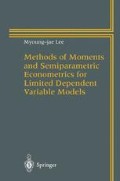Abstract
For a long time, the standard econometric approach consisted of specifying both the systematic component (e.g., regression functions) and the stochastic component (e.g., the distribution of unobservable “error” terms) fully up to some unknown finite-dimensional parameter vector. Estimation and testing were only concerned with this finite-dimensional parameter vector, for example, by applying least squares methods or maximum likelihood. This approach, however, may be far too restrictive by allowing variability only through the finite-dimensional parameter vector, with the model being not flexible enough to give a good approximation to reality. If the approximation is not sufficiently close, inference based on the model under consideration becomes more or less meaningless.
Access this chapter
Tax calculation will be finalised at checkout
Purchases are for personal use only
Author information
Authors and Affiliations
Rights and permissions
Copyright information
© 1996 Springer Science+Business Media New York
About this chapter
Cite this chapter
Lee, Mj. (1996). Introduction. In: Methods of Moments and Semiparametric Econometrics for Limited Dependent Variable Models. Springer, New York, NY. https://doi.org/10.1007/978-1-4757-2550-6_1
Download citation
DOI: https://doi.org/10.1007/978-1-4757-2550-6_1
Publisher Name: Springer, New York, NY
Print ISBN: 978-1-4757-2552-0
Online ISBN: 978-1-4757-2550-6
eBook Packages: Springer Book Archive

